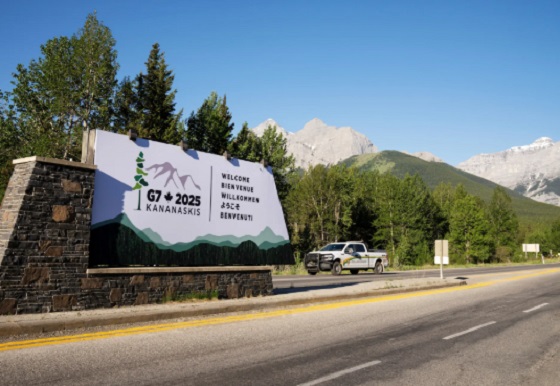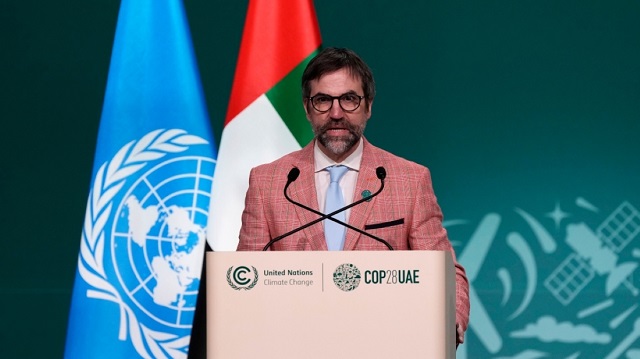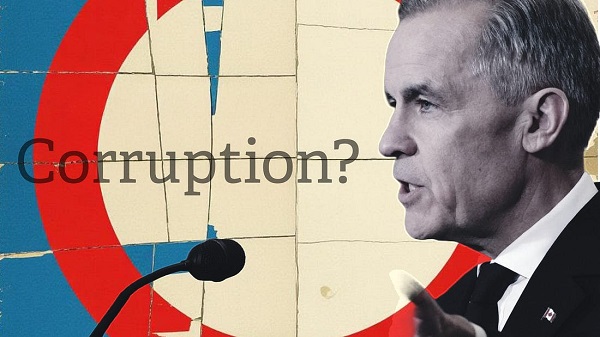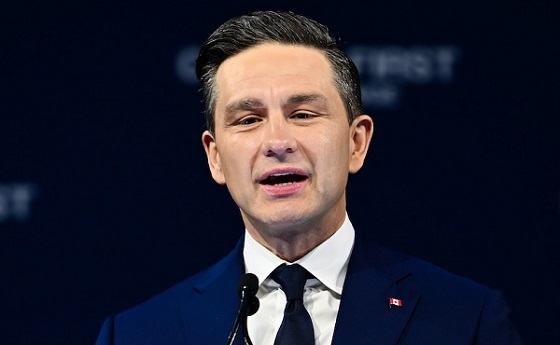Uncategorized
Over 7K-strong, migrant caravan pushes on; still far from US

TAPACHULA, Mexico — Thousands of Central American migrants resumed an arduous trek toward the U.S. border Monday, with many bristling at suggestions there could be terrorists among them and saying the caravan is being used for political ends by U.S. President Donald Trump.
The caravan’s numbers have continued to grow as they walk and hitch rides through hot and humid weather, and the United Nations estimated that it currently comprises some 7,200 people, “many of whom intend to continue the march north.”
However, they were still at least 1,140 miles (1,830
The same could well happen this time around as some turn back, splinter off on their own or decide to take their chances on asylum in Mexico — as 1,128 have done so far, according to the country’s Interior Department.
While such caravans have occurred semi-regularly over the years, this one has become a particularly hot topic ahead of the Nov. 6 midterm elections in the U.S., and an immigrant rights activist
“It is a shame that a president so powerful uses this caravan for political ends,” said Irineo Mujica of the group Pueblo Sin Fronteras — People Without Borders — which works to provide humanitarian aid to migrants.
Some have questioned the timing so close to the vote and whether some political force was behind it, though by all appearances it began as a group of about 160 who decided to band together in Honduras for protection and snowballed as they moved north.
“No one is capable of organizing this many people,” Mujica said, adding that there are only two forces driving them: “hunger and death.”
Earlier in the day Trump renewed threats against Central American governments and blasted Democrats via Twitter for what he called “pathetic” immigration laws.
In another tweet, he blamed Guatemala, Honduras and El Salvador for not stopping people from leaving their countries. “We will now begin cutting off, or substantially reducing, the massive foreign aid routinely given to them,” he wrote.
A team of AP journalists
It was clear, though, that more migrants were continuing to join the caravan.
Ana Luisa Espana, a laundry worker from Chiquimula, Guatemala, joined the caravan as she saw it pass through her country.
Even though the goal is to reach the U.S. border, she said: “We only want to work and if a job turns up in Mexico, I would do it. We would do anything, except bad things.”
Denis Omar Contreras, a Honduran-born caravan leader also with Pueblo Sin Fronteras, said accusations that the caravan is
“There isn’t a single terrorist here,” Contreras said. “We are all people from Honduras, El Salvador, Guatemala and Nicaragua. And as far as I know there are no terrorists in these four countries, at least beyond the corrupt governments.”
The migrants, many of them with blistered and bandaged feet, left the southern city of Tapachula in the early afternoon Monday under a burning sun bound for Huixtla, about 25 miles (40
In interviews along the journey, migrants have said they are fleeing widespread violence, poverty and corruption. The caravan is unlike previous mass migrations for its unprecedented large numbers and because it largely sprang up spontaneously through word of mouth.
Carlos Leonidas Garcia Urbina, a 28-year-old from Tocoa, Honduras, said he was cutting the grass in his father’s yard when he heard about the caravan, dropped the shears on the ground and ran to join with just 500 lempiras ($20) in his pocket.
“We are going to the promised land,” Garcia said, motioning to his fellow
Motorists in pickups and other vehicles have been offering the migrants rides, often in overloaded truck beds, and a male migrant fell from the back of one Monday and died.
“It is the responsibility of the driver, but it is very dangerous, and there you have the consequences,” Mexican federal police officer Miguel Angel Dominguez said, pointing to a puddle of blood around the man’s head.
Police started stopping crowded trucks and forcing people to get off.
Caravan leaders have not defined the precise route or decided where on the U.S. border they want to arrive, but in recent years most Central American migrants
Late Sunday, authorities in Guatemala said another group of about 1,000 migrants had entered that country from Honduras.
Red Cross official Ulises Garcia said some injured people refused to be taken to clinics or hospitals.
“We have had people who have ankle or shoulder injuries, from falls during the trip, and even though we have offered to take them somewhere where they can get better care, they have refused, because they fear they’ll be detained and deported,” Garcia said.
Roberto Lorenzana, a spokesman for El Salvador’s presidency, said his government hopes tensions over the caravan decrease after the U.S. elections.
“We have confidence in the maturity of United States authorities to continue strengthening a positive relationship with our country,” Lorenzana said.
Asked if he thinks Trump will follow through on his threat to cut aid to El Salvador, he said, “I don’t know. Of course the president has a lot of power, but they will have to explain it there to the different government structures.”
Lorenzana added that El Salvador has significantly reduced violence, a key driver of migration, and that the flow of Salvadoran migrants has dropped 60
U.N. deputy spokesman Farhan Haq said large numbers of migrants were still arriving in Mexico and were “likely to remain in the country for an extended period.”
The first waves of migrants began arriving in the southern town of Huixtla after an exhausting eight-hour trek and quickly staked out grassy spots in the town square to bed down overnight.
Marlon Anibal Castellanos, a 27-year-old former bus driver from San Pedro Sula, Honduras, roped a bit of plastic tarp to a tree to shelter his wife, 6-year-old son and 9-year-old daughter.
Castellanos said the family walked for six hours until they could go no farther. They saw the dead man who fell from the truck, and the danger of being on the road was troublesome, out in the middle of the countryside far from an ambulance or medical care should the kids to pass out in the heat.
“It’s hard to travel with children, Castellanos said.”
___
Associated Press writers Peter Orsi in Mexico City, Edie Lederer at the United Nations and Marcos Aleman in San Salvador, El Salvador, contributed to this report.
Mark Stevenson, The Associated Press
Uncategorized
CNN’s Shock Climate Polling Data Reinforces Trump’s Energy Agenda


From the Daily Caller News Foundation
As the Trump administration and Republican-controlled Congress move aggressively to roll back the climate alarm-driven energy policies of the Biden presidency, proponents of climate change theory have ramped up their scare tactics in hopes of shifting public opinion in their favor.
But CNN’s energetic polling analyst, the irrepressible Harry Enten, says those tactics aren’t working. Indeed, Enten points out the climate alarm messaging which has permeated every nook and cranny of American society for at least 25 years now has failed to move the public opinion needle even a smidgen since 2000.
Appearing on the cable channel’s “CNN News Central” program with host John Berman Thursday, Enten cited polling data showing that just 40% of U.S. citizens are “afraid” of climate change. That is the same percentage who gave a similar answer in 2000.
Dear Readers:
As a nonprofit, we are dependent on the generosity of our readers.
Please consider making a small donation of any amount here.
Thank you!
Enten’s own report is an example of this fealty. Saying the findings “kind of boggles the mind,” Enten emphasized the fact that, despite all the media hysteria that takes place in the wake of any weather disaster or wildfire, an even lower percentage of Americans are concerned such events might impact them personally.
“In 2006, it was 38%,” Enten says of the percentage who are even “sometimes worried” about being hit by a natural disaster, and adds, “Look at where we are now in 2025. It’s 32%, 38% to 32%. The number’s actually gone down.”
In terms of all adults who worry that a major disaster might hit their own hometown, Enten notes that just 17% admit to such a concern. Even among Democrats, whose party has been the major proponent of climate alarm theory in the U.S., the percentage is a paltry 27%.
While Enten and Berman both appear to be shocked by these findings, they really aren’t surprising. Enten himself notes that climate concerns have never been a driving issue in electoral politics in his conclusion, when Berman points out, “People might think it’s an issue, but clearly not a driving issue when people go to the polls.”
“That’s exactly right,” Enten says, adding, “They may worry about in the abstract, but when it comes to their own lives, they don’t worry.”
This reality of public opinion is a major reason why President Donald Trump and his key cabinet officials have felt free to mount their aggressive push to end any remaining notion that a government-subsidized ‘energy transition’ from oil, gas, and coal to renewables and electric vehicles is happening in the U.S. It is also a big reason why congressional Republicans included language in the One Big Beautiful Bill Act to phase out subsidies for those alternative energy technologies.
It is key to understand that the administration’s reprioritization of energy and climate policies goes well beyond just rolling back the Biden policies. EPA Administrator Lee Zeldin is working on plans to revoke the 2010 endangerment finding related to greenhouse gases which served as the foundation for most of the Obama climate agenda as well.
If that plan can survive the inevitable court challenges, then Trump’s ambitions will only accelerate. Last year’s elimination of the Chevron Deference by the Supreme Court increases the chances of that happening. Ultimately, by the end of 2028, it will be almost as if the Obama and Biden presidencies never happened.
The reality here is that, with such a low percentage of voters expressing concerns about any of this, Trump and congressional Republicans will pay little or no political price for moving in this direction. Thus, unless the polls change radically, the policy direction will remain the same.
David Blackmon is an energy writer and consultant based in Texas. He spent 40 years in the oil and gas business, where he specialized in public policy and communications.
Uncategorized
Kananaskis G7 meeting the right setting for U.S. and Canada to reassert energy ties


Energy security, resilience and affordability have long been protected by a continentally integrated energy sector.
The G7 summit in Kananaskis, Alberta, offers a key platform to reassert how North American energy cooperation has made the U.S. and Canada stronger, according to a joint statement from The Heritage Foundation, the foremost American conservative think tank, and MEI, a pan-Canadian research and educational policy organization.
“Energy cooperation between Canada, Mexico and the United States is vital for the Western World’s energy security,” says Diana Furchtgott-Roth, director of the Center for Energy, Climate and Environment and the Herbert and Joyce Morgan Fellow at the Heritage Foundation, and one of America’s most prominent energy experts. “Both President Trump and Prime Minister Carney share energy as a key priority for their respective administrations.
She added, “The G7 should embrace energy abundance by cooperating and committing to a rapid expansion of energy infrastructure. Members should commit to streamlined permitting, including a one-stop shop permitting and environmental review process, to unleash the capital investment necessary to make energy abundance a reality.”
North America’s energy industry is continentally integrated, benefitting from a blend of U.S. light crude oil and Mexican and Canadian heavy crude oil that keeps the continent’s refineries running smoothly.
Each day, Canada exports 2.8 million barrels of oil to the United States.
These get refined into gasoline, diesel and other higher value-added products that furnish the U.S. market with reliable and affordable energy, as well as exported to other countries, including some 780,000 barrels per day of finished products that get exported to Canada and 1.08 million barrels per day to Mexico.
A similar situation occurs with natural gas, where Canada ships 8.7 billion cubic feet of natural gas per day to the United States through a continental network of pipelines.
This gets consumed by U.S. households, as well as transformed into liquefied natural gas products, of which the United States exports 11.5 billion cubic feet per day, mostly from ports in Louisiana, Texas and Maryland.
“The abundance and complementarity of Canada and the United States’ energy resources have made both nations more prosperous and more secure in their supply,” says Daniel Dufort, president and CEO of the MEI. “Both countries stand to reduce dependence on Chinese and Russian energy by expanding their pipeline networks – the United States to the East and Canada to the West – to supply their European and Asian allies in an increasingly turbulent world.”
Under this scenario, Europe would buy more high-value light oil from the U.S., whose domestic needs would be back-stopped by lower-priced heavy oil imports from Canada, whereas Asia would consume more LNG from Canada, diminishing China and Russia’s economic and strategic leverage over it.
* * *
The MEI is an independent public policy think tank with offices in Montreal, Ottawa, and Calgary. Through its publications, media appearances, and advisory services to policymakers, the MEI stimulates public policy debate and reforms based on sound economics and entrepreneurship.
As the nation’s largest, most broadly supported conservative research and educational institution, The Heritage Foundation has been leading the American conservative movement since our founding in 1973. The Heritage Foundation reaches more than 10 million members, advocates, and concerned Americans every day with information on critical issues facing America.
-

 International1 day ago
International1 day agoPoland’s president signs new zero income tax law for parents with two children
-

 Business2 days ago
Business2 days agoFederal Budget 2025: A responsible media would ensure Canadians know about the dismal state of federal finance
-

 Business2 days ago
Business2 days agoCanada has an energy edge, why won’t Ottawa use it?
-

 Business2 days ago
Business2 days agoEthics on Ice: See You Next Year
-

 International1 day ago
International1 day agoAustralian territory bans men from women’s prisons in national first
-

 National1 day ago
National1 day agoPoilievre accuses Canada’s top police force of ‘covering up’ alleged Trudeau crimes
-

 Business1 day ago
Business1 day agoFord’s Whisky War
-

 Alberta2 days ago
Alberta2 days agoDiploma Exams Affected: No school Monday as ATA rejects offer of enhanced mediation






